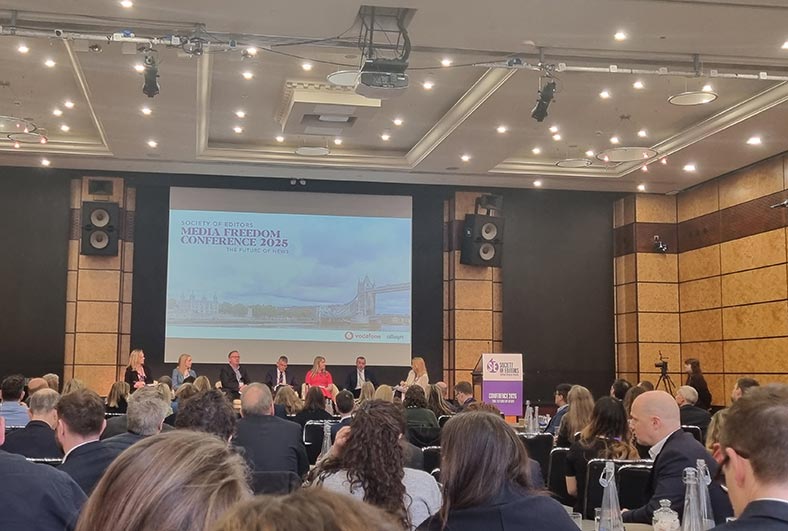Blog / Events / Journalists
Four key takeaways from the Society of Editors ‘Future of News’ Conference

What does the future of news look like in the UK? As with any industry, the media is constantly changing and adapting to the world around it. At the Society of Editors conference last week, journalists and publishers gathered to discuss what the future of news might look like across a variety of panels. This covered everything from trust in the media, to the impact of AI, and the risks of reporting.
Knowing where the audience is
Many publishers have pivoted away from print over the last decade, but for Toby Granville, editorial development director at Newsquest, there is still value in the printed word:
‘The print and digital revenue is still around 50/50 for advertising, but our circulation revenue is still enormous compared to what we get for our digital subscriptions. We have focused on better front pages, higher local story counts, and news that’s actually relevant to the older readers, because the average age of our print reader is around 65 or 70’.
Will Payne, director of digital (editorial) at The Sun, agreed that from a cover price perspective print is still huge for their business. However, the key now is ‘writing content for audiences, rather than writing content for platforms,’ and making sure not to lose sight of what the audience wants.
While print is still popular with the older generation, other readers (especially the younger audience) are increasingly finding the news through social media, as Mitali Mukherjee, acting director at the Reuters Institute, pointed out:
‘If you look at how audiences approach the news, only about 20% (across 50 countries) tend to arrive at the news platform. A third go there via search and then a third of them are approaching the news via social media platforms’.
Winning back and keeping trust
The media’s relationship with the police has been strained in recent years. John Battle, head of legal and compliance at ITN, suggested a document to ‘define the relationship between the media and the police’ with the ‘minimum standards that you can expect as a reporter from the police’. While Martin Evans, crime editor at The Telegraph, said it’s about rebuilding trust:
‘When you do actually get hold of somebody (to speak to from the police), it’s whether or not that person has the confidence to trust in you to share information beyond what is in the press release. When I worked in the North East, I knew all the press officers in the local forces really well and we would meet regularly, so those conversations became a lot easier. I guess the only way to improve that now is more conversations’.
On the other side of the coin, readers aren’t always fully trusting of the news, but making local news a priority, and more personal, seems to be working. Toby Granville highlighted how Newsquest has 50-55 newsrooms across the country in town centres, showing they are ‘part of the community’. For Will Payne at The Sun, it’s been about letting people ‘see the personalities behind the content’ and likewise Debbie Ramsay, editor of 5 News, has found that Dan Walker’s ‘empathetic style’ of guiding viewers through the news was resonating with them.
Mitali Mukherjee, from her work at the Reuters Institute, highlighted one extra point to help build trust:
‘For audiences, it is motive. Who is the business owner behind this news organisation? What is the financial motive for doing this investigative story? I think that’s an important space to start building trust from.’
Money to be made from showbiz journalism
Celebrity news outlets may not be at the height they were in the 1990s and early noughties, as Camilla Tominey, associate editor at The Telegraph, highlighted with stats. But, Clemmie Moodie, assistant editor (showbiz) at The Sun, believes there will ‘always be a thirst for knowledge’ about celebrities. That seems to be playing out according to Katie Hind, consultant editor showbusiness at The Mail:
‘We now have about 250,000 digital subscribers across Mail+ and our app and a large amount of those subscriptions come from showbiz. Readers are prepared to pay for something that’s quality, premium, and a bit more in depth. I think showbiz is becoming a very lucrative part of journalism’.
This point was backed up by Kerri-Ann Roper, head of entertainment & lifestyle at PA Media, who believes that ‘more and more people are wanting to consume celebrity and showbiz news. We’ve heard a lot today about people not engaging with news content and I think celebrity is a really good gateway. It drives engagement online and is a great way of engaging with younger audiences, too’.
Investment needed in journalist safety
The safety of journalists has been a growing concern over the last few years. Dr Rebecca Whittington, online safety editor at Reach plc, revealed that during her three and a half years in the role, there has been a 60% increase year on year in online abuse reports. She also highlighted research from Women in Journalism and UNESCO global reach which reported that 75% of women working in journalism had experienced some kind of online harm, abuse, or violence connected to their work.
Rebecca said that the safety of journalists needs to be ‘the fundamental core of what we need to be achieving’ and that ‘the only thing that we can control is identifying risk and then looking to see how we can put things in place to actually help a journalist do the best job that they can do in the safest way possible’. This sentiment was echoed by Catalina Cortes, acting emergencies director at the Committee to Protect Journalists:
‘News outlets need to understand that they have to invest in safety. It has to be part of the budget and has to be a priority. If they don’t, journalists will not be able to do their jobs’.




